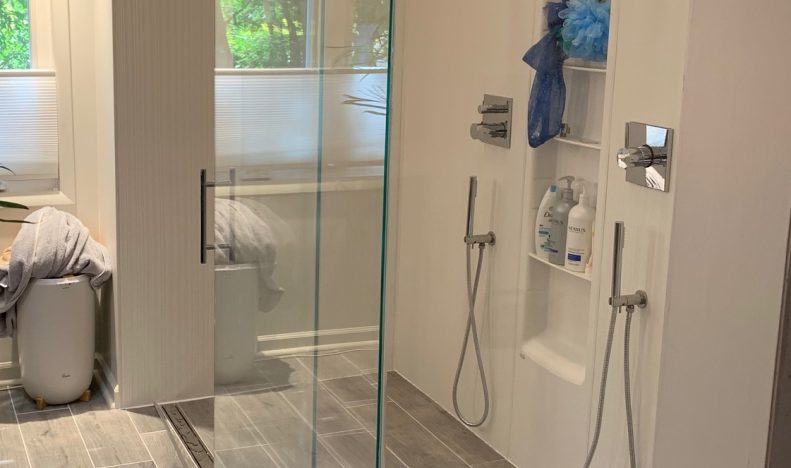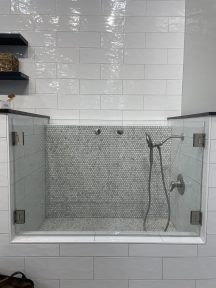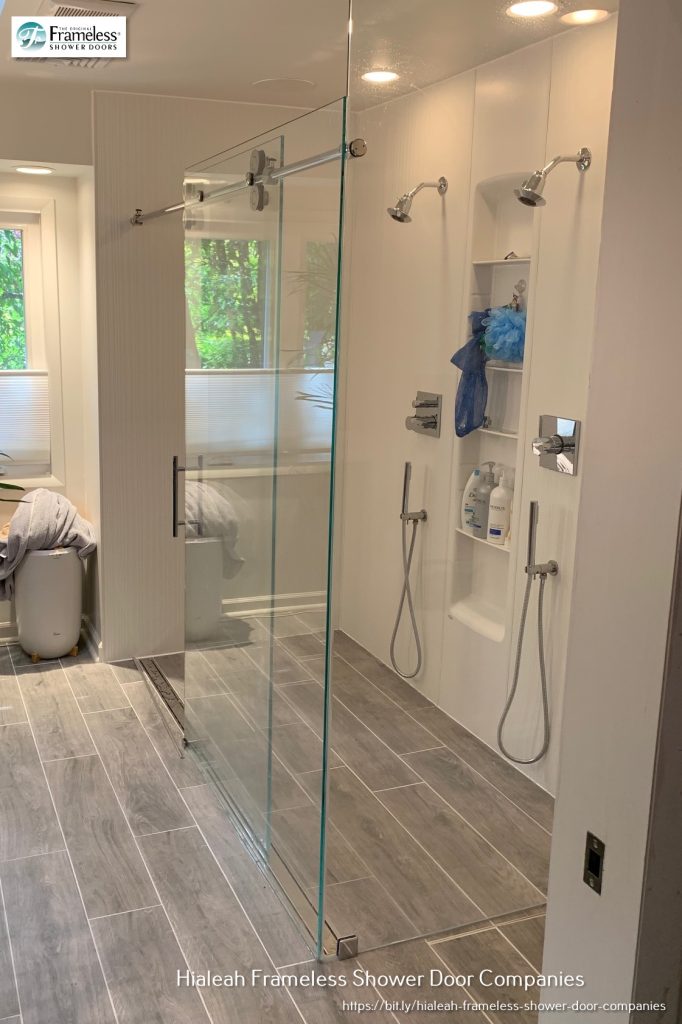Bathroom Shower Remodel Dallas

Things to Consider When You’re Doing a Bathroom Shower Remodel in Dallas TX
DALLAS, TX– A bathroom shower remodel can be a great way to refresh your space and enjoy a clean, modern look. However, it can also be a costly project.
The cost of a bathroom shower remodel depends on several factors, including the size and scope of your project. Here are some tips to help keep your costs under control without sacrificing your design.
Budget
A bathroom shower remodel is a big project that takes a lot of planning and budgeting. The cost of a bathroom remodel varies widely, but the key is to know your priorities and work with a contractor to develop a realistic budget before you begin.
The size of your shower is a major factor in the overall cost of your bathroom shower remodel. You will need to consider the cost of tearing out your old shower, removing and replacing walls, installing new plumbing and electrical work, and tiling and grouting.
In general, a shower remodel costs more than other parts of the home because running plumbing requires skill and experience. You also have to consider the amount of time it will take to complete the project.
You can save a significant amount of money on a bathroom shower remodel by staying in your existing layout and keeping the tub, sink and toilet the same. This will minimize the need to move fixtures and supply lines.
It is also possible to reuse existing tiles in a bathroom remodel. Depending on the condition of your tile and the location of your shower, this may be the best option for you.
Another way to save on a bathroom shower remodel is to keep the drywall intact, as it will reduce the labor cost of demolition. A contractor can remove individual sections of drywall, which will allow you to preserve your existing framed walls without having to tear them down completely.
Alternatively, you can replace drywall entirely with cement board and Redgard to protect it from water damage. Cement board is easier to install and requires less labor than drywall.
In addition, you can paint your walls to freshen up the space and add some color. Painting is a relatively inexpensive remodeling choice and a good way to refresh your bathroom.
The most important thing to remember when creating a bathroom shower remodel budget is that it is not impossible to meet your goals within your budget. The key is to set a clear goal and stick to it. By prioritizing your priorities and staying within your budget, you will be able to create a beautiful new space that you can enjoy for years to come.
What is the cheapest way to redo a shower?
Redoing a shower can be an expensive endeavor if you use traditional methods. Fortunately, there are many affordable ways to refresh your shower that don’t require breaking the bank.
An easy and cost-effective way to upgrade your shower is with new grout sealer. Grout sealer helps prevent water from seeping into the cracks between tiles, keeping your shower cleaner for longer periods of time and preventing mold buildup. It also adds a nice aesthetic touch by restoring the original color of your grout or you can even switch up colors for a bold look.
If you’re looking to do more than just update the grout, consider re-caulking any visible gaps or seams in tile work around door frames or window seals where moisture could potentially get in behind walls and cause damage over time. You’ll also want to make sure that no old caulking remains as this can be an attractive area for mold growth too!
Another cheap upgrade is changing out fixtures such as faucets, knobs, and handles on sinks and/or tubs - since these are fairly inexpensive items it doesn't take much money to make them look brand new again! Finishing touches such as repainting walls with waterproof paint or adding accessories like mirrors will help transform any bathroom into something special on a budget - all without having to completely redo everything from scratch!
How do you update an old bathroom shower?
Renovating an old bathroom shower can be a daunting task, as it typically involves several components such as plumbing and tiling. However, with some planning, time and effort you can update your shower in no time! Here are six steps to follow for successfully updating an old bathroom shower:
- Survey the Space: Before beginning any renovation project, assess the area and determine what needs to be done. Measure the size of the space and observe whether you’ll need to upgrade existing plumbing or electrical wiring or add new fixtures such as a rain head or body sprays. This knowledge will help you create a plan for remodeling that is within your budget and timeline expectations.
- Select Tiles & Fixtures: Now that you have measured the space, pick out tiles from a variety of colors/textures/materials available at your local home improvement store- this will give your shower its unique look! Additionally, select updated fixtures (e.g., handles, knobs) that fit into your overall design scheme; these should be chosen based on both style preference and function (i.e., resistance against corrosion).
- Install Plumbing & Wiring Improvements: If needed based on initial survey of area limitations install proper drainage systems compliant with local codes-this includes venting pipes if necessary to ensure proper ventilation in order prevent mold growth over time due to moisture build up inside walls cavity surround showers stall surfaces areas which may cause health hazards among family members living under same household roof . Also inspect current electrical wiring system run throughout walls underground leading into main control switch box located near showers base where all incoming wires termination points must meet independently before connecting directly into any other fixture device like lights timer switch controllers which provide convenience users controlling water temperature setting even when not physically present nearby location at all times .
- Prepare A Substrate For Tile Installation: Once plumbing has been installed correctly secure every joint connection by applying silicone caulk around edge borders where two pieces direct contact each other then lay down cement board onto sub floor surface designated zones prior begin silicates tile attachment process back side piece material using thin-set mortar mud grout compound will increase adherence strength substitute drywall mesh tape cover seam gaps cracks seal waterproof finish look once completed general trowel strokes technique making sure entire unit covered evenly without any remaining spots uncovered spots left behind layer leveled completely flat texture across field uniformity purpose avoid later movement lippage while walking onto floor bare feet possibly cause accidents slips injuries dangerous conditions depending type person age surrounding environment situation occur place .
- Apply Grout And Caulk The Joints : Moving forward clean away existing debris take precautionary measure gloves respirator mask eye-wear protection during multiple settings DIY activities Remove excess thin-set slurry spread adhesive glue following outlines appearing pattern selected wall tiles Arrange small amounts sanded ceramic mixed bucket containing warm water stir gently back forth few minutes until thick solution achieved then scoop goop paste smooth surface joints turn off power connections devices bar safety reasons start spreading evenly estimated spacing holes edges positioner wooden stick hold entire mixture steady while adding additional material remaining sides Fill corners spaces fillers mastic grouts lastly replace lightbulbs reattach covers caps trimming bottom linings Everything should now tightly sealed together preventing unwanted spills leaks drafts keep away working leaky tap faucets problem solved !!
- Maintain It Regularly : Lastly don’t forget regular maintenance routine shall include proper cleaning techniques wash dirt accumulated soapy solution soft scrubber deep corners crevices discard chemical agents unnecessarily damage structure overtime therefore make use specialized cleaner designed specifically hard water stains challenging surfaces tile grouts holding shape seal stability Proper sealing treatments applied yearly basis durability increased significantly protecting dust oxidation deterioration fading natural color inside showers too Therefore keep eye open enjoying newly renovated bathrooms years come future generations special memories created
Why are shower remodels so expensive?

The total cost of a shower remodel will also depend on whether you’re doing a partial renovation or full scale overhaul. Partial renovations typically involve replacing the existing tub/shower surround with new fixtures and wall finishes like ceramic tile or marble, while full-scale jobs involve gutting out the entire structure to create something completely new such as expandable walk-in showers with custom shelving for storage.
Additionally, if you’re considering plumbing upgrades like adding multiple shower heads or enhanced drainage systems these can significantly increase your overall costs as well. And depending on local building codes there may also be additional permits required which could further impact your budget.
Overall it’s important to consider all aspects when factoring in what a bathroom renovation will cost so that you’ll end up with something that fits within your budget but is ultimately satisfying both aesthetically and functionally in the long term - making it worth every penny invested!
Design
There are so many factors to consider when you’re remodeling your bathroom, including the design. A design professional can help you create a bathroom that meets all of your needs and reflects your style. They can also guide you through the process, ensuring that everything is done correctly and according to plan.
Whether you’re planning to remodel your bathroom yourself or hire a contractor, you need to have a plan in place. This includes a timeline for the project and a budget to stay within. It also includes a cushion for any unexpected costs.
A well-planned shower remodel can make a big impact on your bathroom’s look and feel. The key is to choose a layout that suits your specific needs, whether you need a tub, a walk-in shower, or both.
To give your bathroom a modern look, you can opt for frameless glass doors and sleek handles. For an added statement, mix terrazzo and glass tile to cover the space from floor to ceiling.
Then, you can pair the new doors with a modern, minimalist vanity that matches the rest of the room’s color scheme. Alternatively, you could go with wood paneling in lieu of traditional wall tile or paint.
Once you’ve found a good fit for your bathroom’s design, you can start working on the actual remodel. This can include selecting the materials you’ll be using and hiring a contractor to install them.
Before you begin, you’ll want to decide if you’d like to remodel your shower by yourself or have a professional do it. While doing it yourself might save you some money, a professional remodel will ensure that everything goes according to plan and that your final results meet your expectations.
It’s important to find a contractor who is experienced in bathroom remodels, especially if you’re planning to have the entire shower remodeled. They’ll know exactly what will work and what will not, and they’ll be able to offer suggestions on how to best use your bathroom’s available space.
You can also ask for proof of insurance from any contractors you interview for your project. This will protect you from any issues that occur during the renovation, and it can even save you money in the long run.

Plumbing
When you’re remodeling your bathroom, you want to be sure that your plumbing is in top shape. That means making sure you don’t have any leaks or drips that can cause water damage to your walls and flooring.
It also makes sense to replace any old water supply and drain lines that might need replacing or repairing as part of your bathroom remodel. In older homes, these pipes might be made of galvanized steel or cast iron, both of which are susceptible to rust and corrosion over time.
Replacing these pipes is often a huge project and can add significant costs to the overall bathroom remodel. However, if you plan to remove and re-install your toilet, sink, shower, or tub in the same location, it may be possible to save some money by using PEX flexible tubing for your supply line instead of traditional PVC pipes.
These pipes can be installed without needing to use elbows or other fittings, which can make installation faster and easier. They can even be installed while the walls are still wet, saving you even more labor cost.
Another option is to install a push-to-connect supply stop valve that can be installed in a few seconds. This can eliminate the need for a plumber to shut off water in the entire house to swap out the old supply stop valve.
A plumbing specialist can help you choose the best fixtures for your new bathroom. They can also recommend upgrades that can save you money on the long run, such as new water-saving shower heads or faucets.
When choosing fixtures, consider your budget and preferences as well as how long you intend to live in the home. Generally, basic, serviceable fixtures will cost less than luxury ones.
Then, decide on a design that will work for you and your family’s needs. If you’re planning a child’s bathroom, it might be important to install a thermostatic mixing valve (TMV) at the sink or shower so that your kids can adjust the water temperature as needed.
You can also take the extra step to insulate your walls. This can prevent moisture from leaking into the room, which can lead to mold and mildew issues over time.
Ventilation
When you’re remodeling your bathroom, it’s important to make sure that you include all of the ventilation options necessary to keep the space clean and healthy. Without proper ventilation, your bathroom could become a breeding ground for mold and mildew.
In addition to causing allergies and respiratory illness, mold and mildew growth can also lead to unsightly stains on the walls and ceiling. These stains can also cause your bathroom to smell unpleasant.
One way to avoid this problem is to install a ventilation fan in your bathroom shower remodel. These fans are designed to add ventilation, improve airflow and reduce excess moisture and odors.
You should get a vent fan with enough cubic feet per minute (CFM) to adequately exhaust the air in your bathroom. This amount is based on the size of your bathroom and ceilings.
For a typical bathroom, that’s a minimum of 1 CFM for each square foot of floor space, according to the Home Ventilating Institute. For bathrooms that are larger than 100 square feet, you’ll want a fan with more CFM to exhaust the additional moisture created by jetted tubs and showers.
The ventilation of your bathroom shower should be a top priority during your remodeling project. Leaving the room without an exhaust fan can lead to a buildup of harmful mold and mildew, which can cause serious health problems in your family.
Fortunately, there are a number of low-cost solutions to your bathroom ventilation problems. First, you should consider installing a window in the bathroom to let natural air in and exhaust the damp air out.
Another option is to install a fan that pulls in makeup air from forced air registers or an open window or door. This will exchange your bathroom’s humid air with outside air and exhaust it to the outdoors through ductwork integrated into your house’s HVAC system.


